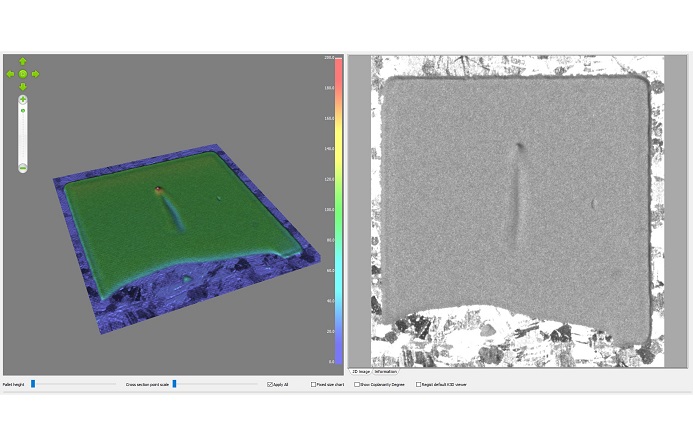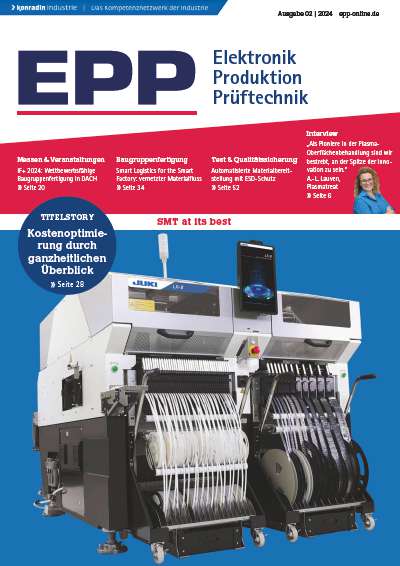To boost the production of its DC/DC converters, Artesyn in Ireland partnered with Universal Instruments to find an assembly solution that enabled greater process automation and an increase in throughput by a remarkable 400%. This goal was achieved without sacrificingmanufacturing quality – just the opposite seems true.
Artesyn Technologies is one of the leading suppliers of power supplies to the networking, wireless communications, computing and telecom industries. The billion-dollar, Nasdaq–listed US company employs over 7000 people through its operations in Europe, Asia and America, and has a customer list that includes prestigious blue chip giants. As well as producing a wide range of standard products, the manufacturer works closely with its customers to fulfill their specific requirements through modifications to standard as well as full-custom designed products.
The company’s European headquarters, which serves as a center of design and manufacturing excellence for its power conversion products worldwide, is based at the picturesque seaside town of Youghal in Cork, Ireland. This facility has experienced tremendous growth and, as an independent cost center, is now a $70m business employing over 500 people. This location also houses their largest surface mount assembly operation in Europe, and currently produces over two million SMT and mixed-technology power supplies per year.
“This corresponds to around 50,000 units per week,” states Billy Milner, manufacturing engineering manager at the Youghal site, “but like any major electronics industry, the power-supply market is extremely competitive and dynamic. As a result, we are under constant pressure to drive down the cost of our products, reduce their size, increase their performance, and to react instantly to changes in demand. Allied to this, consistent quality is an absolute given with our OEM customers who will not tolerate variation in the performance or reliability of our products.“ These marketing and commercial pressures have posed a continual challenge to the commerce’s ability to maintain its ‘edge’ in manufacturing competitiveness. “Without doubt,” he adds, “the assembly area that has had the single largest impact upon our production efficiencies and costs, is placement of components”.
Thoroughly examinedmajor equipment sources
Artesyn has been producing SMT-based units since 1990. And by 1997, due to the rapid growth, its production requirements, especially in terms of throughput capacity, had outgrown the capabilities of its existing lines. “Although we had become well-experienced at finding efficient solutions for the assembly of our PCBs, the existing pick&place machinery could no longer offer us the throughput, flexibility and level of automation we required, given the increasing production volumes”, explains the production manager. “We therefore decided to look for a new placement solution, and examined equipment from all the major suppliers.
“We were also looking for a vendor with a well-established, credible name within the industry, and a proven track record of delivering high-performance placement machines with the in-built technological growth path to stay abreast of new assembly developments via ongoing equipment up-grades. We have seventy people employed in design in the Youghal site alone, and are constantly innovating to stay ahead with the products we produce.”
After extensive in-depth analysis, Artesyn selected Universal as its equipment vendor that best met these criteria, and offered the best placement solution for its needs. As a result, in May 1997 the Irish manufacturer installed a SMT assembly line, based around a high speed 4796HSP and flexible GSM1 placer combination. “For our application, the Universal machines offered the most efficient solution available on the market,” resumes Milner. “And the flexibility and range of components that the GSM1 could place was enormous. This, combined with the speed of the HSP, enabled us to meet our rapidly increasing capacity requirements, and substantially reduce the cost per placement of our SMT boards. We were also able to automate placement of some odd-form components that previously required manual intervention.”
Second line without hesitation
The line proved so successful that, when the company needed to meet further capacity increases in 1999, it installed a second line without hesitation. This has had significant impact upon its throughput capacity: By the end of this year, the SMD placement volumes will have risen 400% since 1997, from 55m to just over 200m (projected) annually placements.
Although the business is deeply involved with the design and manufacture of both AC-to-DC and DC-to-DC power supplies, its core manufacturing competence at the Youghal site is in the assembly of sub-50W, fully SMT-based DC/DC converters. These use boards that range from 50 x 25mm up to 50 x 75mm in size, and are assembled on the two lines. The latest line also utilizes a GDM adhesive dispenser, and is primarily used to manufacture open-frame power supplies. Through superior thermo-mechanical design, the company has been able to eliminate encapsulation while delivering higher performance. Due to their compact size (one version is even available as a surface mount component in its own right), they are produced as double-sided FR4 assemblies.
The two Universal lines are otherwise configured identically with a 4796HSP and GSM1 placer combination following high-speed MPM screen printers. The earlier line focuses on the high-volume assembly of their more traditional power boards which are typically aluminum-based in order to effectively dissipate heat. Following assembly, both lines then feed into standard reflow soldering and 100% visual inspection and functional test. Utilizing the intrusive reflow process has eliminated the requirement for wave and hand soldering.
Flexible and high-speed shooter
The GSM family also exploits the powerful design concept of using a single base machine or platform, with common interfaces on every ancillary part from feeders, placement heads and vision systems to provide maximum flexibility. This means that the placer can be easily upgraded or customized to accommodate design developments, or, as in this case, one or two highly unusual components. Additionally, the same machine platform is used as a dispenser in GDM format. The 4796HSP is a high-speed, turret-based chipshooter. It exploits an outstanding, direct-drive, 16 station turret head arrangement (five nozzles per station), and vision recognition system to reliably place components ranging from 0201-chips up to 20mm square devices at rates up to 36,000cph. “With the arrival of each Universal line we assigned a group of manufacturing engineers to fully realize their throughput and capabilities in terms of further automating the assembly of our existing range of SM products,” continues the manufacturing specialist. In addition to standard SMDs such as 0603s, SOICs and SOT89s, the DC converter boards use some odd-form devices that need automatic placement. These included inductors, transformers, flex windings, planer magnetics, and 1mm square SMT press-fit posts. “Although we found that the sheer flexibility of the GSM1 meant that it could essentially place anything, achieving this demanded a lot of peripheral work. Some of the key transformer and inductor components used in our typical DC/DC converters, for example, are so unusual that most production engineers will have never seen them before.”
“We therefore had to find ways to actually feed the odd-form devices to the GSM1, developing custom vision libraries, and designing nozzles so that the system could pick&place these components. Universal was so willing to help us achieve our objective of automating the placement of our full range of components, that we were able to achieve this both successfully and quickly with their assistance.” To solve the feeding of odd forms (primarily inductors and transformers), both companies jointly developed a set of unique vacuum-formed waffle trays and customized the GSM’s optional matrix tray handling mechanism to be able to handle them.
Highest possible success rate
“The programmable matrix tray has proven to be an excellent tool that has given us an additional level of flexibility for being able to present odd-forms to the GSM. It minimizes reloading requirements by being able to house a stack of component trays. And it automates the removal of empty trays to further optimize our utilization of the GSM and eliminate the production downtime associated with tray removal.” For the majority of the production batches, Milner now uses both the lines on a flat-out, 24-hour, three-shift basis; and confirms that he has not experienced major downtime on either. “Universal’s technical support has been everything we were looking for, and any minor problems that we have experienced were worked through in a rapid and professional manner through the help of their 24-hour helpdesk or a field service engineer,” he states. “This has given us the ability to accurately plan our production levels, while yielding an excellent level of asset utilization.”
“By combining the speed of the 4796HSP with the flexibility of the GSM1, we have been able to achieve outstanding placement rates which has given us the ability to react instantly to changes in demand for our supplies. In addition, the equipment has brought us leading-edge process reliability and repeatability, together with the highest level of automation that we could have achieved, given the variety and complexity of the devices used in our power supplies. It has also enabled us to build our product with the highest possible success rates.” Artesyn has dramatically increased its throughput capacity due to the improved speed, flexibility and efficiency of the Universal placement solution, and has been able to redeploy a larger number of manual operators from both its SMT lines. This has resulted in major cost savings, and significantly enhanced assembly quality by eliminating „classic“ hand assembly problems such as missing or incorrectly positioned components.
“We have had the machines in-house for three years now, and our relationship with Universal has continued to develop over that time into a highly productive partnership,” summarizes Milner. “Whenever we identify a problem or challenge we know we can discuss it with them to find a solution, and have any required hardware rapidly developed and delivered”. Since this recent survey for the case study, Artesyn has placed an order with Universal for a third complete line at the Youghal site. This can be taken as another sign for a successful and profound partnering.
zusammenfassung
Mit zwei Linien, die sowohl Exoten als auch Standard- und Advanced-Packages flexibel und schnell bestücken, konnte ein Stromversorgungshersteller seinen Bestückungsdurchsatz um bemerkenswerte 400 % steigern. Dabei konnte sowohl noch die Bestücksicherheit deutlich verbessert als auch die Arbeitskosten gesenkt werden.
Résumé
Avec deux lignes de montage permettant d’équiper tant les composants exotiques que les packages standard et advanced, rapidement et avec souplesse, un fabricant d’alimentations électriques pourrait augmenter sonrendement d’implantation de 400 %. Ceci permettrait d’améliorer considérablement la fiabilité de l’implantation et de réduire les coûts de travail.
Sommario
Con due linee in grado di equipaggiare in maniera rapida e flessibile sia Packages di tipo Standard o Advanced che Packages „esotici„, un costruttore nel settore dell‘alimentazione di corrente è riuscito ad aumentare il rendimento del suo equipaggiamento di ben 400%. Il tutto con un notevole miglioramento della sicurezza di equipaggiamento ed una sensibile riduzione dei costi di lavorazione.
Fax +49-6101-808-222
EPP 154
Unsere Webinar-Empfehlung
Applikationen aus dem Bereich der Leistungselektronik gewinnen immer mehr an Bedeutung. Die Inspektion dieser Applikation lässt sich mit der bewährten Standardtechnologie der 3D-Messtechnik bewerkstelligen.
Teilen:














